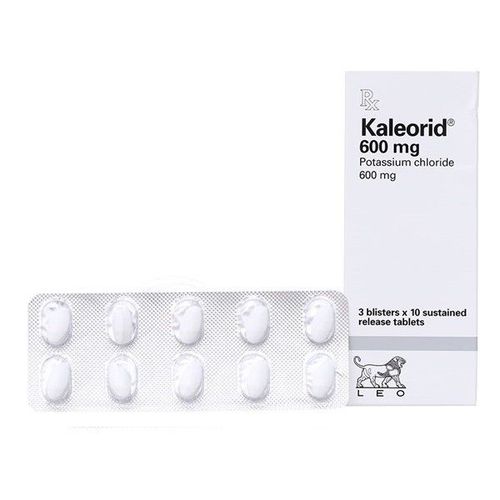Kaleorid 600mg is a type of electrolyte supplement used to replenish potassium ions in the body. It is commonly prescribed for patients suffering from potassium deficiency, which can negatively impact health. The following article provides detailed information about Kaleorid 600mg, its uses, effects, and how to properly use it, including the recommended dosage.

1. Information about Kaleorid 600mg
Kaleorid 600mg belongs to the group of electrolyte medications (vitamins and minerals). It is not a disease-specific treatment. The active ingredient in each 600mg tablet of Kaleorid is potassium chloride, which is often formulated in tablet form for ease of use and portability. Potassium chloride is a mineral found in many foods and is an essential nutrient for the body.
What is the effect of Kaleorid 600mg on health?
Potassium deficiency in the blood, known as hypokalemia, can lead to noticeable symptoms such as fatigue, muscle weakness, changes in electrocardiogram (ECG) readings, increased stimulation of the heart's ventricles, and depolarization disorders. Kaleorid 600mg is prescribed to restore potassium levels in the blood, often in combination with other medications such as corticosteroids, laxatives, or diuretics, which may cause potassium depletion. This medication is also used in various health conditions related to blood potassium levels, such as:
- Patients using digitalis, which can lead to severe arrhythmias (irregular heartbeats).
- Patients with kidney failure, leading to decreased potassium levels.
- Patients experiencing diarrhea accompanied by dehydration and electrolyte imbalances.
- Bartter syndrome in both children and adults, especially when treated with long-term corticosteroids.
2. What is the specific dose of Kaleorid 600mg?
For adults, Kaleorid 600mg is typically prescribed at a dose ranging from 1 to 10 tablets per day, depending on the degree of potassium deficiency in the body. The dosage should be divided into multiple smaller doses if the total number of tablets per day is too high. Currently, there are no recommended guidelines for its use in children.
In patients with kidney failure, the dosage of Kaleorid 600mg must be reduced and adjusted accordingly.
3. How to use Kaleorid 600mg effectively?
It is essential to carefully read the instructions and follow the doctor's recommendations to ensure proper and rational use of the medication. Additionally, when taking the medication, it should be swallowed whole without chewing or crushing the tablet, as this may reduce the amount of potassium available to the body.
Adhering strictly to the prescribed dosage is crucial; never take more or less than directed, and do not stop using the medication without consulting your healthcare provider.
4. Important precautions when using Kaleorid 600mg
Precautions and warnings when taking Kaleorid:
Before taking Kaleorid, ensure that you are not allergic to any of the ingredients, especially potassium chloride. Regular monitoring of blood potassium levels before and during treatment with Kaleorid 600mg is also necessary.
Kaleorid 600mg requires extra caution when used in elderly patients or those with heart, kidney, or liver problems, as well as pregnant women or those breastfeeding (particularly in the first six months).
Contraindications for Kaleorid 600mg:
There are certain groups of patients for whom taking Kaleorid is contraindicated:
- Patients with severe electrolyte imbalances, such as hypercalcemia (high calcium), hyperkalemia (high potassium), or hyperchloremia (high chloride) or any health condition that causes hyperkalemia.
- Patients with adrenal insufficiency or kidney failure.
- Patients with esophageal constriction, pyloric stenosis, delayed gastric emptying, or intestinal obstruction.

What are the potential side effects of Kaleorid 600mg?
Although Kaleorid 600mg is a medication in the vitamins and minerals group, in some cases, it may cause adverse side effects, including:
- Blood and lymphatic system disorders such as leukopenia (low white blood cells), agranulocytosis (absence of granulocytes), or neutropenia (low neutrophil count).
- Nutritional and metabolic disorders, particularly hyperkalemia (excessive potassium in the blood).
- Gastrointestinal disturbances such as nausea, gastric cramps, stomach pain, bloating, indigestion, diarrhea, stomach ulcers, esophageal ulcers, duodenal ulcers, and bowel perforation.
- Dermatological reactions such as rashes, urticaria (hives), and skin itching.
However, these side effects are relatively rare.
Drug interactions with Kaleorid 600mg
Kaleorid 600mg can interact with certain medications that increase potassium levels in the blood, such as amiloride, spironolactone, canrenone, tacrolimus, cyclosporine, or angiotensin-converting enzyme inhibitors, or angiotensin II receptor antagonists. This interaction may increase the risk of hyperkalemia, which can be life-threatening, especially in patients with kidney dysfunction.
How to store Kaleorid 600mg?
Kaleorid 600mg is relatively easy to store. It should be kept in a cool, dry place away from moisture and sunlight, at room temperature. Avoid storing the medication in the bathroom or freezer, as extreme temperatures can reduce its effectiveness.
In summary, Kaleorid 600mg is an electrolyte supplement used to treat potassium deficiency when it cannot be quickly replenished through diet and nutrition. However, its use must always be approved by a healthcare provider, and it should never be used on a self-prescribed basis.
For more useful information, be sure to follow Vinmec.com.
Please dial HOTLINE for more information or register for an appointment HERE. Download MyVinmec app to make appointments faster and to manage your bookings easily.
To arrange an appointment, please call HOTLINE or make your reservation directly HERE. You may also download the MyVinmec app to schedule appointments faster and manage your reservations more conveniently.








